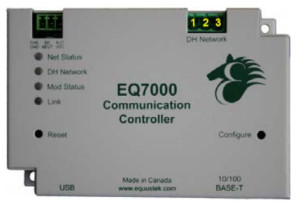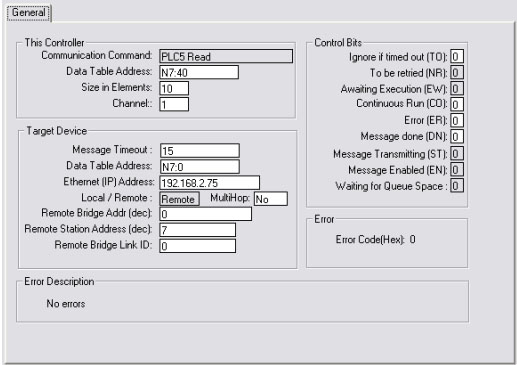How to split the DF1 Port of SLC500, MicroLogix, CompactLogix, PLC5, ControlLogix or any Allen Bradley DF1 Port Device.
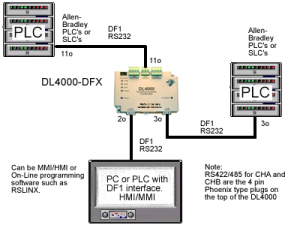

In case you have the serial DF1 port of an Allen Bradley PLC, like PLC5, SLC 5/05 1747-L551, SLC 5/03 1747-L533, CompactLogix 1768, CompactLogix 1769, Control Logix 5563, MicroLogix 1400 (1766 MicroLogix ), MicroLogix 1200 (1762 MicroLogix ), MicroLogix 1100 ( 1763 MicroLogix ), MicroLogix 1000 ( 1761 MicroLogix ), or any DF1 device where the DF1 port is already being used and you want to connect another DF1 device to it, usually you would get the Allen Bradley 1747-DPS1 DF1 port splitter but that is being discontinued by Allen Bradley and now your best solution out there is Equustek’s DL4000-DFX which allows three DF1 serial devices to simultaneously communicate with each other, below is the link to DL4000 page .
https://www.equustek.com/dl-4000-dfx-df1-to-df1/
The DL4000 can be programmed with other firmware versions to perform other protocol conversions, such as;
DL4000-DMX allows DF1 to communicate with MODBUS and can be configured for MODBUS master or MODBUS slave, it also can be configured to connect via RS232, RS422 or RS485.
https://www.equustek.com/dl4000-dmx-modbus-df1/
DL4000-MMX interfaces MODBUS RTU to MODBUS ASCII (Allows Modbus RTU devices to communicate with multiple Modbus ASCII devices), also can be configured to do RS232, RS422 or RS485.
https://www.equustek.com/dl-4000-mmx-modbus-rtu-modbus-ascii/
DL4000-DAS Interfaces serial ASCII devices (Scanners/Printers) to AB DF1 protocol.
https://www.equustek.com/dl-4000-das-df1-ascii/
DL4000-MAS Interfaces ASCII device to MODBUS RTU Slave.
https://www.equustek.com/dl-4000-mas-modbus-ascii-converter/
DL4000-PM Provides a DF1 Half Duplex Master Interface to Allen Bradley Power Monitor 3000 then sends the converted data via Modbus to specified Slave RTU devices.

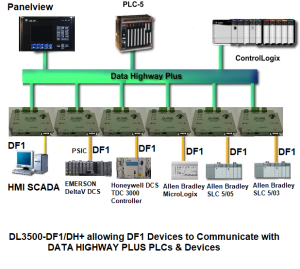 Many Allen Bradley PLCs, like MicroLogix 1400 (1766 MicroLogix ), MicroLogix 1200 (1762 MicroLogix ), MicroLogix 1100 ( 1763 MicroLogix ), MicroLogix 1000 ( 1761 MicroLogix ), CompactLogix 1768, CompactLogix 1769, SLC 5/05 1747-L551, SLC 5/03 1747-L533, and other manufacturers Distributed Control Systems (DCS), like the Honeywell DCS (TDC 3000) or the Emerson DeltaV DCS with PSIC (Programmable Serial Interface Card) that have a serial RS232 DF1 port, most of the time they need to communicate with an Allen Bradley Data Highway Plus (DH+) device like the PLC-5, SLC 5/04, ControlLogix 1756-DHRIO, a Panel View, or any other DH+ device. The solution for that used to be using one of Allen Bradley’s 1770-KF2 or the 1785-KE to interface between the DF1 and DH+ by connecting the DF1 side to the RS232 DF1 port, while the other side (DH+) would be daisy chained to the Data Highway Plus Network, but Allen Bradley phased out the 1785-KE and 1770-KF2, both now are obsolete. So what options are out there for the plant to continue working until they are ready for an upgrade to Industrial Ethernet IP?
Many Allen Bradley PLCs, like MicroLogix 1400 (1766 MicroLogix ), MicroLogix 1200 (1762 MicroLogix ), MicroLogix 1100 ( 1763 MicroLogix ), MicroLogix 1000 ( 1761 MicroLogix ), CompactLogix 1768, CompactLogix 1769, SLC 5/05 1747-L551, SLC 5/03 1747-L533, and other manufacturers Distributed Control Systems (DCS), like the Honeywell DCS (TDC 3000) or the Emerson DeltaV DCS with PSIC (Programmable Serial Interface Card) that have a serial RS232 DF1 port, most of the time they need to communicate with an Allen Bradley Data Highway Plus (DH+) device like the PLC-5, SLC 5/04, ControlLogix 1756-DHRIO, a Panel View, or any other DH+ device. The solution for that used to be using one of Allen Bradley’s 1770-KF2 or the 1785-KE to interface between the DF1 and DH+ by connecting the DF1 side to the RS232 DF1 port, while the other side (DH+) would be daisy chained to the Data Highway Plus Network, but Allen Bradley phased out the 1785-KE and 1770-KF2, both now are obsolete. So what options are out there for the plant to continue working until they are ready for an upgrade to Industrial Ethernet IP?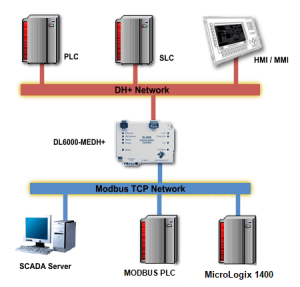 If you are in a situation where you have an Allen Bradley MicroLogix 1400 with MODBUS TCP/IP support, and you want it to communicate with the DH+ network devices like Allen Bradley’s PLC5 and SLC5/04, where the MicroLogix Ethernet port is configured for MODBUS TCP/IP Master so that it can get data from any DH+ Device ( PLC5s and SLC504s), or the other way when the DH+ Nodes or devices like PLC5 or SLC5/04 wants to get data from MicroLogix which it’s Ethernet port is configured in this case for MODBUS TCP/IP Slave, that said not many easy affordable solutions are out there, however Equustek Solutions
If you are in a situation where you have an Allen Bradley MicroLogix 1400 with MODBUS TCP/IP support, and you want it to communicate with the DH+ network devices like Allen Bradley’s PLC5 and SLC5/04, where the MicroLogix Ethernet port is configured for MODBUS TCP/IP Master so that it can get data from any DH+ Device ( PLC5s and SLC504s), or the other way when the DH+ Nodes or devices like PLC5 or SLC5/04 wants to get data from MicroLogix which it’s Ethernet port is configured in this case for MODBUS TCP/IP Slave, that said not many easy affordable solutions are out there, however Equustek Solutions 


